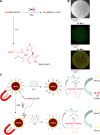Gold nanoparticle-based colorimetric method for the detection of prostate-specific antigen
- PMID: 29731627
- PMCID: PMC5923276
- DOI: 10.2147/IJN.S154046
Gold nanoparticle-based colorimetric method for the detection of prostate-specific antigen
Abstract
Background: Prostate-specific antigen (PSA), a serine protease, is a biomarker for preoperative diagnosis and screening of prostate cancer and monitoring of its posttreatment.
Methods: In this work, we reported a colorimetric method for clinical detection of PSA using gold nanoparticles (AuNPs) as the reporters. The method is based on ascorbic acid (AA)-induced in situ formation of AuNPs and Cu2+-catalyzed oxidation of AA. Specifically, HAuCl4 can be reduced into AuNPs by AA; Cu2+ ion can catalyze the oxidation of AA by O2 to inhibit the formation of AuNPs. In the presence of the PSA-specific peptide (DAHSSKLQLAPP)-modified gold-coated magnetic microbeads (MMBs; denoted as DAHSSKLQLAPP-MMBs), complexation of Cu2+ by the MMBs through the DAH-Cu2+ interaction depressed the catalyzed oxidation of AA and thus allowed for the formation of red AuNPs. However, once the peptide immobilized on the MMB surface was cleaved by PSA, the DAHSSKLQ segment would be released. The resultant LAPP fragment remaining on the MMB surface could not sequestrate Cu2+ to depress its catalytic activity toward AA oxidation. Consequently, no or less AuNPs were generated.
Results: The linear range for PSA detection was found to be 0~0.8 ng/mL with a detection limit of 0.02 ng/mL. Because of the separation of cleavage step and measurement step, the interference of matrix components in biological samples was avoided.
Conclusion: The high extinction coefficient of AuNPs facilitates the colorimetric analysis of PSA in serum samples. This work is helpful for designing of other protease biosensors by matching specific peptide substrates.
Keywords: Cu2+ ion; ascorbic acid; colorimetric assay; gold nanoparticles; prostate-specific antigen.
Conflict of interest statement
Disclosure The authors report no conflicts of interest in this work.
Figures







Similar articles
-
Gold Nanoparticle-based Biosensors for Point-of-Care Diagnostics: A Review of Sensing Nanoparticle Applications and Future Prospects.Comb Chem High Throughput Screen. 2025;28(3):417-434. doi: 10.2174/0113862073293557240320065128. Comb Chem High Throughput Screen. 2025. PMID: 38551055 Review.
-
A novel label-free colorimetric aptasensor for sensitive determination of PSA biomarker using gold nanoparticles and a cationic polymer in human serum.Spectrochim Acta A Mol Biomol Spectrosc. 2020 Feb 5;226:117644. doi: 10.1016/j.saa.2019.117644. Epub 2019 Oct 9. Spectrochim Acta A Mol Biomol Spectrosc. 2020. PMID: 31614271
-
Colorimetric immunosensor for determination of prostate specific antigen using surface plasmon resonance band of colloidal triangular shape gold nanoparticles.Spectrochim Acta A Mol Biomol Spectrosc. 2019 Nov 5;222:117218. doi: 10.1016/j.saa.2019.117218. Epub 2019 May 29. Spectrochim Acta A Mol Biomol Spectrosc. 2019. PMID: 31174151
-
Platinum-Decorated Gold Nanoparticles with Dual Functionalities for Ultrasensitive Colorimetric in Vitro Diagnostics.Nano Lett. 2017 Sep 13;17(9):5572-5579. doi: 10.1021/acs.nanolett.7b02385. Epub 2017 Aug 18. Nano Lett. 2017. PMID: 28813601
-
Gold Nanoparticle-Based Colorimetric Sensors: Properties and Application in Detection of Heavy Metals and Biological Molecules.Sensors (Basel). 2023 Sep 29;23(19):8172. doi: 10.3390/s23198172. Sensors (Basel). 2023. PMID: 37837002 Free PMC article. Review.
Cited by
-
Nanotreatment and Nanodiagnosis of Prostate Cancer: Recent Updates.Nanomaterials (Basel). 2020 Aug 28;10(9):1696. doi: 10.3390/nano10091696. Nanomaterials (Basel). 2020. PMID: 32872181 Free PMC article. Review.
-
Fiber optic sensor based on ZnO nanowires decorated by Au nanoparticles for improved plasmonic biosensor.Sci Rep. 2019 Oct 30;9(1):15605. doi: 10.1038/s41598-019-52056-1. Sci Rep. 2019. PMID: 31666617 Free PMC article.
-
Nanoribbon Biosensor-Based Detection of microRNA Markers of Prostate Cancer.Sensors (Basel). 2023 Aug 30;23(17):7527. doi: 10.3390/s23177527. Sensors (Basel). 2023. PMID: 37687982 Free PMC article.
-
Development of label-free gold nanoparticle based rapid colorimetric assay for clinical/point-of-care screening of cervical cancer.Nanoscale Adv. 2020 Oct 7;2(12):5737-5745. doi: 10.1039/d0na00686f. eCollection 2020 Dec 15. Nanoscale Adv. 2020. PMID: 36133887 Free PMC article.
-
Gold Nanoparticle-based Biosensors for Point-of-Care Diagnostics: A Review of Sensing Nanoparticle Applications and Future Prospects.Comb Chem High Throughput Screen. 2025;28(3):417-434. doi: 10.2174/0113862073293557240320065128. Comb Chem High Throughput Screen. 2025. PMID: 38551055 Review.
References
-
- Ibau C, Md Arshad MK, Gopinath SCB. Current advances and future visions on bioelectronic immunosensing for prostate-specific antigen. Biosens Bioelectron. 2017;98:267–284. - PubMed
-
- Gao Z, Xu M, Hou L, Chen G, Tang D. Magnetic bead-based reverse colorimetric immunoassay strategy for sensing biomolecules. Anal Chem. 2013;85:6945–6952. - PubMed
-
- Suaifan GA, Shehadeh M, Al-Ijel H, Ng A, Zourob M. Recent progress in prostate-specific antigen and HIV proteases detection. Expert Rev Mol Diagn. 2013;13:707–718. - PubMed
MeSH terms
Substances
LinkOut - more resources
Full Text Sources
Other Literature Sources
Medical
Research Materials
Miscellaneous

